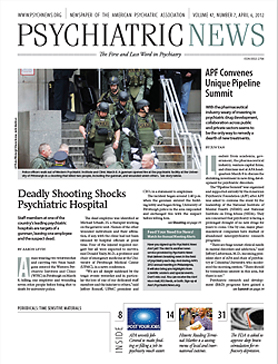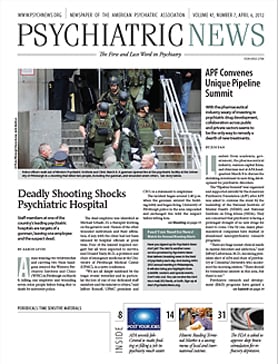Leaders from academia, government, the pharmaceutical industry, venture-capital firms, and clinicians met at APA headquarters March 8 to discuss the shrinking investment in new drug development for psychiatric disorders.
The “Pipeline Summit” was organized and supported entirely by the American Psychiatric Foundation (APF) after APF was asked to convene the event by the leadership of the National Institute of Mental Health (NIMH) and National Institute on Drug Abuse (NIDA). They are concerned that psychiatry is facing a prolonged drought of no new drugs for years to come. One by one, major pharmaceutical companies have slashed or abandoned neuropsychiatric research programs.
“There are huge unmet clinical needs in mental disorders and addiction,” said Jeffrey Lieberman, M.D., incoming president-elect of APA and chair of psychiatry at Columbia University, who moderated the morning session. “There should be tremendous interest in this area, but there is not.”
Psychiatric research and development (R&D) programs have gained a high-cost, high-risk, and no-return reputation in industry after dozens of failed programs, agreed senior managers from several major companies at the summit.
Steven Paul, M.D., pointed out that the industry as a whole is challenged with “less innovation, longer development cycles, shrinking margins, and less investment in R&D.” About 1 percent of molecules entering phase 1 clinical development ever get to see the light of day as marketed products.
Paul previously headed the research division at Eli Lilly and Co. and is now director of the Helen and Robert Appel Institute for Alzheimer’s Research at Weill Cornell Medical College.
After a number of expensive failures in recent years, companies have shifted resources to anti-inflammatory and oncology development, which are perceived as less risky and more profitable.
Atul Pande, M.D., senior vice president of Neurosciences MDC at GlaxoSmithKline (GSK), recounted his involvement in the termination of 14 early-stage clinical programs on new drugs investigated for several psychiatric indications. “Not a single one of them generated a shred of positive data,” he said. Each failure means a multimillion-dollar loss for the company. Subsequently, GSK decided to curtail its neuroscience research.
Two senior members from venture-capital firms confirmed that this sense of pessimism about neuropsychiatric research has influenced investors as well. Investment dollars are flowing toward oncology and other diseases and are down some 70 percent over the past few years.
Discoveries Lost in Translation
At the root of the failed initiatives is murky and incomplete understanding of the physiology of mental illnesses, summit participants agreed. Finding the right physiological targets to halt or reverse pathology is at the heart of drug development. In psychiatry, “[a] lot of drug targets [that were] validated in the lab have not panned out in clinical trials,” said Armin Szegedi, M.D., Ph.D., who heads the Clinical Neurosciences and Ophthalmology Department at Merck. The reason? Psychiatric disorders are not single-pathway diseases. For example, what is known as major depressive disorder may be a heterogeneous group of diseases with different etiologies and genetic factors, he said. Targeting one pathway may not help patients with other pathologies, and no one yet knows how to differentiate patients by their biology.
Unlike psychiatry, certain areas in neurology get plenty of investment because investors believe that the mechanisms of these diseases are better understood, according to Paul. These areas include Alzheimer’s disease, pain, Parkinson’s disease, multiple sclerosis, fragile X syndrome, and autism.
The targets for translational research in neurology seem clearer and more plausible than in psychiatry, said Roy Twyman, M.D., global head of central nervous system (CNS) development at Johnson and Johnson. Therefore, companies are pouring billions of dollars into Alzheimer’s drug research.
A pervasive antipsychiatry stigma in society is also a factor in the declining investment in psychiatric drug research, APA past President Alan Schatzberg, M.D., commented. Many within and outside the industry have the impression that plenty of drugs are available to treat all major mental disorders and discovering new antidepressants or antipsychotics is not as important as are new anticancer drugs.
Antipharmaceutical Sentiment
Joseph Belanoff, chief executive officer and director of Corcept Therapeutics, said that based on his experience, the attitude toward industry-sponsored drug research seems very different between endocrinologists and psychiatrists. Corcept is a small company that does drug development in both endocrinology and psychiatry.
Pharma-sponsored research is considered not prestigious and “a bit dirty” among top-notch academic researchers in psychiatry, a sentiment that is absent in endocrinology, said Belanoff.
He urged APA to take a strong stand to support industry research. Others also commented that some academic psychiatry departments are reluctant to collaborate with industry.
Herbert Pardes, M.D., former president and CEO of New York Presbyterian Hospital and New York-Presbyterian Healthcare System and president of the Scientific Council of the Brain and Behavior Research Foundation (formerly NARSAD), disagreed. He commented that if there is an innovative treatment with convincing effectiveness coming out of industry, “the vast majority of psychiatrists will embrace it.” Pardes moderated the afternoon session.
John Krystal, M.D., a professor of translational research and chair of the Department of Psychiatry at Yale University, cited the decline of academic institutions’ capability to conduct neuroimaging, genetics, and other types of translational research. As government funding for academic research continues to fall, these resources are threatened.
For industry-supported research, drug trials are increasingly outsourced to global contract research organizations, and research quality varies. Amir Kalali, MD., vice president of medical and scientific services and CNS global therapeutic team leader at Quintiles, urged APA to “help normalize academia’s relationship with industry” and encourage psychiatrists to take up industry-supported research.
Mudhukar Trivedi, M.D., director of the mood disorders research program at the University of Texas Southwestern, observed that “we are creating a virtual world in which [psychiatric] trials are conducted in the [least-severely ill] patients by the least-qualified people, and then [we] are surprised by the placebo effect.” Consequently, the general public and part of the medical community believe that antidepressants are no better than placebo.
All participants at the Pipeline Summit agreed that the future of psychiatric drug development looks bleak and that the only long-term solution is for all psychiatry stakeholders to share resources and work together. It was suggested that the proposed dimensional approach in DSM-5, along with NIMH’s ongoing development in Research Domain Criteria, could provide more precise clinical and biochemical targets for new and rational drug design.
The participants acknowledged that unlike oncology, neuropsychiatry research lacks a framework to facilitate broader and more synergistic collaboration between public and private sectors.
Drug companies remain reluctant to share shelved molecules with other companies or with academic researchers, but they have begun to share study data to improve study designs and performance.
Academia has begun to combine research efforts. John Hayes, M.D., executive director of the National Network of Depression Centers (NNDC), introduced the network as a consortium of 21 academic medical centers and clinics specializing in treatment of patients with depression across the country. The consortium is modeled after the cancer-research network, which has helped transform oncology research.
Among the members of NNDC are Stanford University, Columbia University and the New York State Psychiatric Institute, the University of Michigan, and Johns Hopkins Mood Disorder Center. These institutions combine research and patient care, both given by experienced clinicians, and uphold a high quality.
“Many of the problems [in current psychiatric research] can be solved with a very large network of very good centers that are balanced in … traditional academic work and translational research,” Hayes said. Member centers can refer patients within the network and share expensive equipment, best-practice knowledge, resources, and expertise. The network facilitates standardized assessments, longitudinal follow-up, and a large database for fruitful analyses, he explained.
APA Can Do More
One of APF and APA’s roles, Schatzberg said, is to continue to fight the stigma against psychiatry and psychiatric drugs. In addition to facilitating more collaboration between the government and the private sector, he proposed that APF and APA work with other stakeholders to create incentives for industry to reinvest in psychiatry. Philip Skolnick, D.Sc., Ph.D., of NIDA raised the issue of whether extending market exclusivity for compounds that are first in class and/or first in indication as is done abroad could promote investment.
Thomas Laughren, M.D., director of the Division of Psychiatric Products at the FDA, suggested that APA could help the agency by organizing public discussions and publishing consensus on clinical endpoints, biomarkers, and standardized clinical definitions such as response and partial response.
In addition, APA will continue to advocate for more favorable reimbursement conditions for psychiatric services and new medical devices for treating mental illness, said Schatzberg.
“APA has a role in shaping what future psychiatric practice looks like,” Schatzberg stated. “More needs to be done now if we are to have new treatments in the next decade for patients with psychiatric disorders.”


